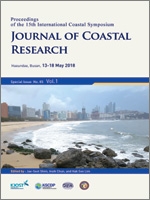Bastos, A.P.; Ponte Lira, C.; Calvão, J.; Catalão, J.; Andrade, C.; Pereira, A.J.; Taborda, R.; Rato, D.; Pinho, P., and Correia, O., 2018. UAV Derived Information Applied to the Morphological Study of Slow-changing Dune Systems. In: Shim, J.-S.; Chun, I., and Lim, H.S. (eds.), Proceedings from the International Coastal Symposium (ICS) 2018 (Busan, Republic of Korea). Journal of Coastal Research, Special Issue No. 85, pp. 226–230. Coconut Creek (Florida), ISSN 0749-0208.
São João da Caparica (Portugal) slow-growing dune system was investigated using field-based GPS and UAV surveying methods. Here, vegetation may preclude straightforward extraction of ground surface data from DSM and low sedimentation rates demand high accuracy. The approach used comprised acquisition of UAV-derived DSM and RGB orthomosaics at flight-heights of 30 and 60 m. Results were compared with DTM derived from traditional RTK-GPS ground surveys. Two methods (M1 and M2) where used to convert UAV-derived DSM into a DTM, both departing from supervised classification of land cover. In M1, vegetation areas are removed from the original DSM, which is then re-interpolated. M2 redefines elevation of pixels corresponding to vegetation by subtracting a mean height parameter defined for each vegetation class.
It was found that DTM derived from UAV and RTK-GPS data exhibit errors in the same order of magnitude, regardless of the higher resolution of the former. M2 yielded the best compromise when considering deviations in both profile and surface analysis. M2 is strongly dependent on vegetation classification and on parametrization of the vertical correction affecting each vegetation class. UAV methodology presents the best cost-benefit ratio relative to traditional RTK-GPS surveys, providing additional image information (RGB orthomosaic) synchronous of the topographic data.





